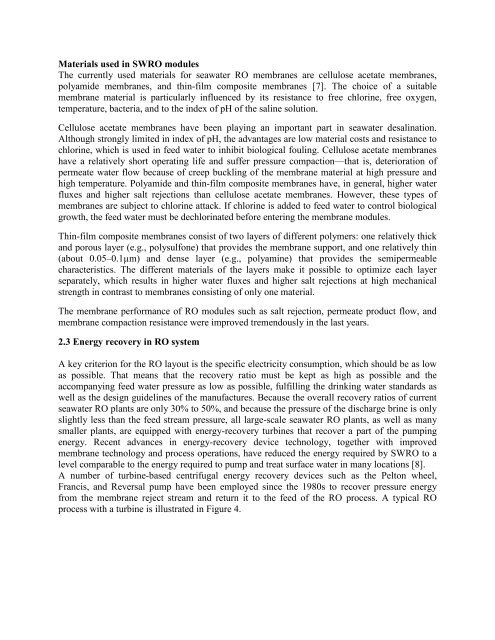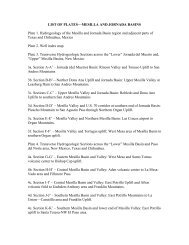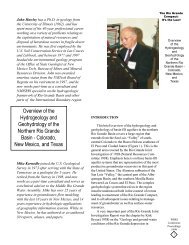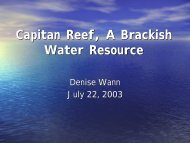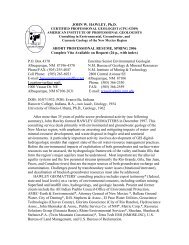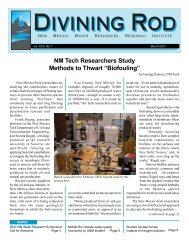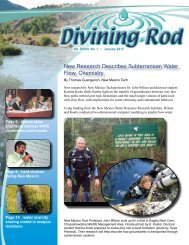Economic and Technical Analysis of a Reverse-Osmosis Water ...
Economic and Technical Analysis of a Reverse-Osmosis Water ...
Economic and Technical Analysis of a Reverse-Osmosis Water ...
You also want an ePaper? Increase the reach of your titles
YUMPU automatically turns print PDFs into web optimized ePapers that Google loves.
Materials used in SWRO modulesThe currently used materials for seawater RO membranes are cellulose acetate membranes,polyamide membranes, <strong>and</strong> thin-film composite membranes [7]. The choice <strong>of</strong> a suitablemembrane material is particularly influenced by its resistance to free chlorine, free oxygen,temperature, bacteria, <strong>and</strong> to the index <strong>of</strong> pH <strong>of</strong> the saline solution.Cellulose acetate membranes have been playing an important part in seawater desalination.Although strongly limited in index <strong>of</strong> pH, the advantages are low material costs <strong>and</strong> resistance tochlorine, which is used in feed water to inhibit biological fouling. Cellulose acetate membraneshave a relatively short operating life <strong>and</strong> suffer pressure compaction—that is, deterioration <strong>of</strong>permeate water flow because <strong>of</strong> creep buckling <strong>of</strong> the membrane material at high pressure <strong>and</strong>high temperature. Polyamide <strong>and</strong> thin-film composite membranes have, in general, higher waterfluxes <strong>and</strong> higher salt rejections than cellulose acetate membranes. However, these types <strong>of</strong>membranes are subject to chlorine attack. If chlorine is added to feed water to control biologicalgrowth, the feed water must be dechlorinated before entering the membrane modules.Thin-film composite membranes consist <strong>of</strong> two layers <strong>of</strong> different polymers: one relatively thick<strong>and</strong> porous layer (e.g., polysulfone) that provides the membrane support, <strong>and</strong> one relatively thin(about 0.05–0.1µm) <strong>and</strong> dense layer (e.g., polyamine) that provides the semipermeablecharacteristics. The different materials <strong>of</strong> the layers make it possible to optimize each layerseparately, which results in higher water fluxes <strong>and</strong> higher salt rejections at high mechanicalstrength in contrast to membranes consisting <strong>of</strong> only one material.The membrane performance <strong>of</strong> RO modules such as salt rejection, permeate product flow, <strong>and</strong>membrane compaction resistance were improved tremendously in the last years.2.3 Energy recovery in RO systemA key criterion for the RO layout is the specific electricity consumption, which should be as lowas possible. That means that the recovery ratio must be kept as high as possible <strong>and</strong> theaccompanying feed water pressure as low as possible, fulfilling the drinking water st<strong>and</strong>ards aswell as the design guidelines <strong>of</strong> the manufactures. Because the overall recovery ratios <strong>of</strong> currentseawater RO plants are only 30% to 50%, <strong>and</strong> because the pressure <strong>of</strong> the discharge brine is onlyslightly less than the feed stream pressure, all large-scale seawater RO plants, as well as manysmaller plants, are equipped with energy-recovery turbines that recover a part <strong>of</strong> the pumpingenergy. Recent advances in energy-recovery device technology, together with improvedmembrane technology <strong>and</strong> process operations, have reduced the energy required by SWRO to alevel comparable to the energy required to pump <strong>and</strong> treat surface water in many locations [8].A number <strong>of</strong> turbine-based centrifugal energy recovery devices such as the Pelton wheel,Francis, <strong>and</strong> Reversal pump have been employed since the 1980s to recover pressure energyfrom the membrane reject stream <strong>and</strong> return it to the feed <strong>of</strong> the RO process. A typical ROprocess with a turbine is illustrated in Figure 4.


